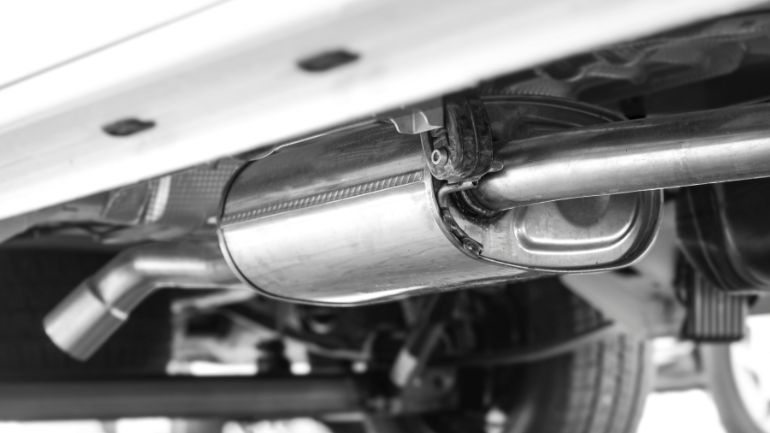Ford Mustangs often have multiple catalytic converters although the specific number depends on the model in question.
For instance, the GT features four catalytic converters. Other models may only have two catalytic converters.
Table of Contents
- What Is A Catalytic Converter?
- How Many Catalytic Converters Are In A Ford Mustang?
- What Does The Catalytic Converter Look Like?
- What Does The Catalytic Converter Do?
- Preventing Ford Mustang Catalytic Converter Theft
- Has My Ford Mustang Cat Been Stolen?
- How Much Will It Cost To Replace A Mustang Catalytic Converter?
- Replacement Cost For 2018 Ford Mustang Catalytic Converter
- Importance Of Pre Catalytic Converters
- When To Replace A Mustang Catalytic Converter
- Can I Change My Mustang Catalytic Converter?
- Will A Vehicle Run After The Catalytic Converter Is Removed?
- Can Catalytic Converters Be Sold For Scrap?
- Are Catalytic Converters Universal?
- Frequently Asked Questions
What Is A Catalytic Converter?
Most people know very little about cars and catalytic converters. Nevertheless, the component is a vital part of the vehicle’s exhaust system.
The system filters pollutants from the engine to make them less harmful to the environment. In particular, the system deals with carbon monoxide, nitrogen oxides, and hydrocarbons.
Catalytic converters have been staples of automobiles since the mid-70s.
How Many Catalytic Converters Are In A Ford Mustang?

Ford Mustangs are considered luxury sports cars. Therefore, it only makes sense for them to contain multiple catalytic converters.
However, the exact number will depend on the model. Some Mustangs only have two while others have four or more catalytic converters.
How Many Cats On A 2001 Mustang 3.8 V6?
Do you own a 2001 Ford Mustang 3.8 V6? Your vehicle contains two catalytic converters. They’re near the end of the exhaust system close to the engine.
How Many Cats On A 2001 Mustang GT?
The 2001 Mustang GT is unique because it has four cats. However, it should be noted that two are pre-cats. There are also two conventional catalytic converters.
There are two cats on each bank. In addition to this, the 2001 Mustang GT has four oxygen sensors. California vehicles may have extra pre-catalytic converters on later vehicle models.
What Does The Catalytic Converter Look Like?
Catalytic converters tend to come in various shapes and sizes. Most are roughly the size and shape of a loaf of bread. In some cases, they’ll resemble a flattened loaf of bread.
The catalytic converter is a part of the exhaust system installed between the muffler and the engine. Since it needs high temperatures to work, the converter is close to the engine.
It is common for cars to have more than one catalytic converter.
What Does The Catalytic Converter Do?
As mentioned above, catalytic converters play an important role in the exhaust system. The component deals with harmful pollutants that will hurt the environment.
The catalytic converter will transform the pollutants into safer emissions before the pollutants are released into the atmosphere.
It performs three tasks, including the reduction of nitrogen oxides, oxidation of hydrocarbons, and oxidation of carbon monoxide.
The car will also sound different when it no longer has a catalytic converter.
Preventing Ford Mustang Catalytic Converter Theft
Since your catalytic converter is so expensive, you’ll want to go above and beyond to protect it from criminals. How many catalytic converters are in a Ford Mustang?
It is common for these vehicles to have four cats. As a result, Ford Mustangs are hot targets for thieves. Thankfully, it is harder to remove cats from Mustangs.
Still, you should always park your vehicle in a well-lit area. It is also a good idea to make sure that your anti-theft system is working.
When you’re parking outside of your residence, use motion sensor lights to keep people away from your vehicle. You can also try painting your catalytic converter.
Certain police departments will paint your catalytic converter for free. You can also get insurance to protect against catalytic converter theft.
It can cost up to $3,000 to have a new catalytic converter installed so getting insurance is a good idea.
Has My Ford Mustang Cat Been Stolen?
If someone has stolen the catalytic converter from your Ford Mustang, you may not realize it immediately. However, you should start noticing a difference soon.
Without a catalytic converter, your vehicle is going to be louder. You’ll hear a loud road when you accelerate and start your vehicle.
You’ll also notice odd smells coming from your exhaust. The lack of exhaust regulation may cause your vehicle to sputter when you accelerate. Your vehicle will not pass an inspection without a catalytic converter.
Finally, your check engine light will turn on when your cat is missing.
If your catalytic converter has been stolen, it is pertinent to report it to the police immediately. You’ll also want to begin working to replace the component.
How Much Will It Cost To Replace A Mustang Catalytic Converter?

Unfortunately, catalytic converters are very expensive and that is why they’re stolen so often.
Plus, you’ll have to pay a mechanic to replace the component for you. It is estimated that catalytic converters for some Ford Mustangs will cost as much as $1,600.
This includes the price of the part and labor costs. To make matters worse, most people will not be able to replace the converter on their own.
Just remember that the price may vary depending on the mechanic you choose, your location, and the year of Mustang you own.
It is best to contact mechanics in your area to ask for quotes. If you’re lucky, you may get the part replaced for less than $1,000.
Replacement Cost For 2018 Ford Mustang Catalytic Converter
Again, the cost of replacing your catalytic converter will depend on several factors including the make and model of the vehicle you have. At the least, you should expect to be charged $1,000 or more.
If you have a 2018 Ford Mustang, the cost may be even higher. For vehicles made before 1981, the price of catalytic converter replacement is between $100 and $600.
Newer vehicles may have three-way catalytic converters that are going to be costlier. The cost can reach $1,500.
Plus, you’ll have to pay for labor. In some cases, it’ll cost up to $2,200 to replace a catalytic converter on a 2018 Ford Mustang.
Importance Of Pre Catalytic Converters
It is common for Ford Mustangs to have catalytic converters and pre-catalytic converters. Both are equally important. What is the purpose of the pre-catalytic converter?
Ultimately, this component increases the overall effectiveness of the primary catalytic converter. The pre-cat is used while the engine is still cool.
As for the main converter, it will not start working until the engine has warmed up. In fact, conventional catalytic converters cannot operate efficiently until they’re warm.
They’re close to the engine to ensure they get warm quickly. The pre-cat is used before the catalytic converter gets hot and starts working.
The only problem is that pre-cats and conventional catalytic converters can go bad so they’ll need to be replaced at some point.
When To Replace A Mustang Catalytic Converter
Most people do not want to replace their catalytic converters because they’re so expensive. While this is understandable, it may be pertinent to replace the component soon.
First, you should begin looking at your dashboard. When the check engine light turns on, you’ll know that something is wrong with your vehicle.
In some cases, this means that the catalytic converter has gone bad. It may be a good idea to have the vehicle inspected to see if something is wrong with the cat.
Another sign of a problematic catalytic converter is having less power. When the converter isn’t working, contaminants are going to clog the engine. Therefore, the vehicle’s performance will drop significantly.
Use your nose to determine whether your catalytic converter should be replaced. If you’ve noticed a rotten egg smell coming from the back of your car, you may need to replace your cat.
Be sure to keep an eye on your fuel economy. If the fuel economy is poorer than usual, it could be a sign of a catalytic converter problem.
Can I Change My Mustang Catalytic Converter?
It may be possible to replace your Mustang catalytic converter, but the job is too difficult for the average person.
Furthermore, you will need special tools and equipment. It is generally best to take the Mustang to a mechanic so they can change the part for you.
Will A Vehicle Run After The Catalytic Converter Is Removed?

A vital component of the automotive exhaust system is the catalytic converter. As the Environmental Protection Agency “EPA” pushes for more regulations to combat greenhouse gases, the significance of the catalytic converter becomes more apparent.
EPA ruled the catalytic converter a “requirement” for all new vehicles in 1975. The laws have not changed, as the device is still required for all commercial and passenger vehicles. Fifteen US states have adopted laws that require owners to have their vehicles annually inspected by an approved inspection station.
Illegal theft operations are targeting catalytic converters throughout the United States. While thieves are profiting greatly, motorists are forced to pay for a replacement. The cost is a major setback for victims but it is necessary to operate a vehicle legally in the United States.
The first sign of a bad or stolen catalytic converter is a Check Engine light. Other signs include an unusually loud roaring noise upon starting the vehicle, harmful fumes, and poor performance. A less significant sign is poor gas mileage.
Can Catalytic Converters Be Sold For Scrap?
Most metal scrap yards buy anything constructed of metal. Metal scrap yards are regulated by state and federal government agencies. Each step of the process must be compliant with the Regulatory Exclusions and Alternative Standards “RCRA.”
Scrap yards are different than salvage yards and junk yards, in that they specialize in scrap made of copper, steel, aluminum, titanium, zinc, and nickel. Catalytic converters are constructed from a selection of metals – rhodium, platinum, and palladium.
Scrap catalytic converters fetch a basic price. The age, condition, or brand does not reflect in the price which is based on weight.
Are Catalytic Converters Universal?
All catalytic converter brands operate in the same manner, collecting harmful exhaust emissions. The design depends on the layout of the make and model of the vehicle. The design must be compatible with the vehicle’s exhaust system. The size is described as being similar to a “loaf of bread.”
If the component does not fit snugly into the designated location, it could compromise the vehicle’s ability to ride smoothly. A few aftermarket brands are now offering “universal” designs for improved cost-efficiency and convenience.
When shopping for an aftermarket universal catalytic converter, it is vital to confirm its compatibility with your Ford Mustang.
Frequently Asked Questions
Does My Car Need A Catalytic Converter?
Technically, you could drive a vehicle without a catalytic converter. Still, doing so is not a good idea. Without a catalytic converter, your vehicle will be louder and more harmful to the environment.
How To Identify A Catalytic Converter?
There are several types of catalytic converters. Therefore, it can be difficult to know what type you have without looking at it carefully. Usually, the information you need is printed or carved onto the converter.
What Will A Car Sound Like Without A Catalytic Converter?
Cars without catalytic converters will be much louder. When you start the vehicle and accelerate, you will hear roaring coming from the back of your car. Look under the vehicle to see if your catalytic converter is missing.

Robert Bacon is a car nerd and automotive lover who has dedicated his life to understanding the inner workings of vehicles. He holds a degree in mechanical engineering and has spent years working as a mechanic and engineer for some of the world’s top car companies. In his spare time, he enjoys writing about cars on this blog and tinkering with his 2016 Toyota Mirai in his garage.